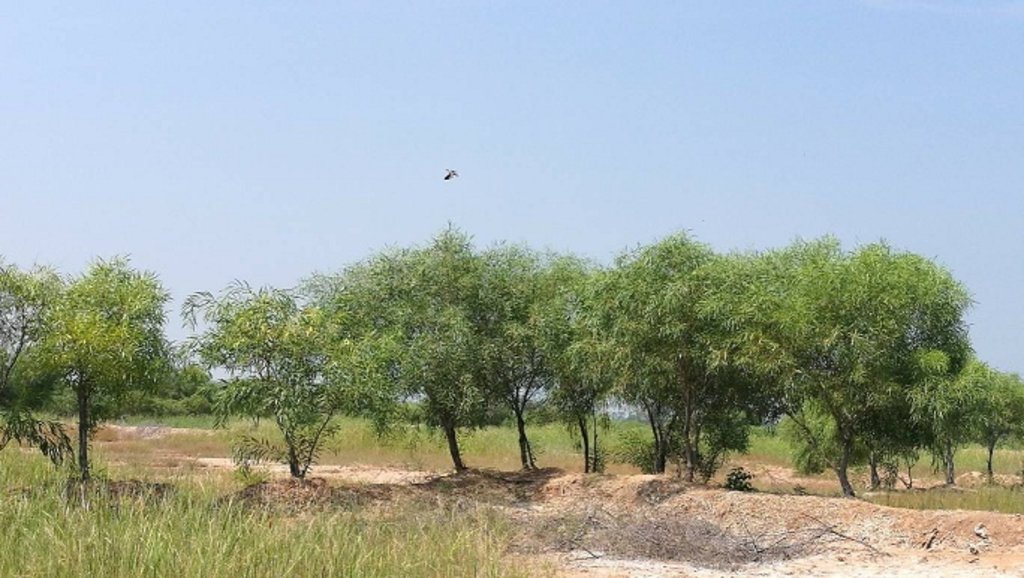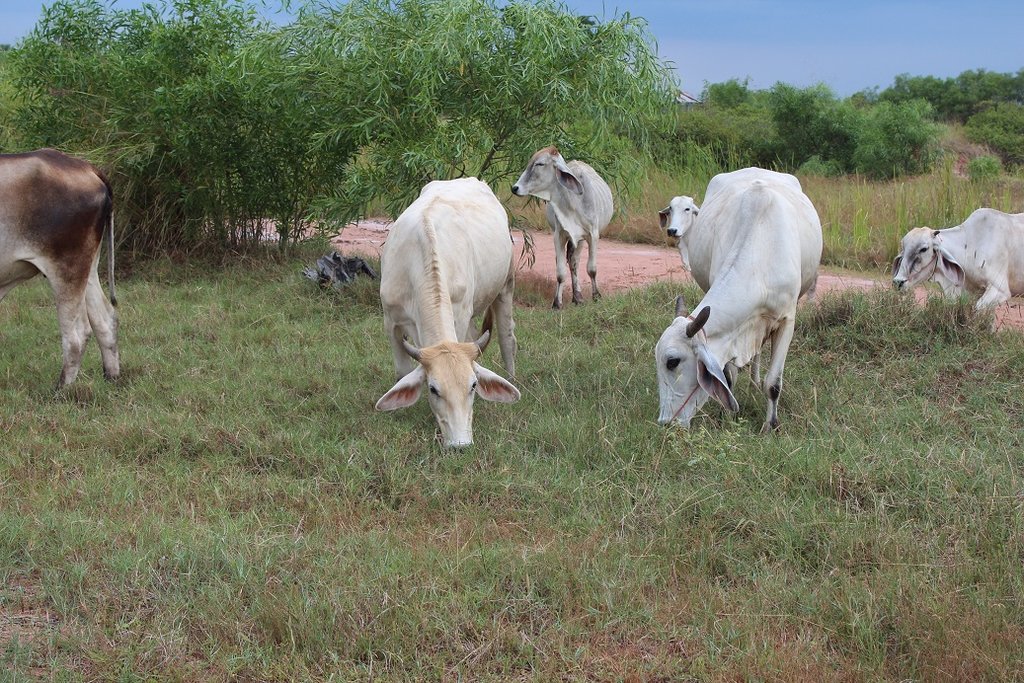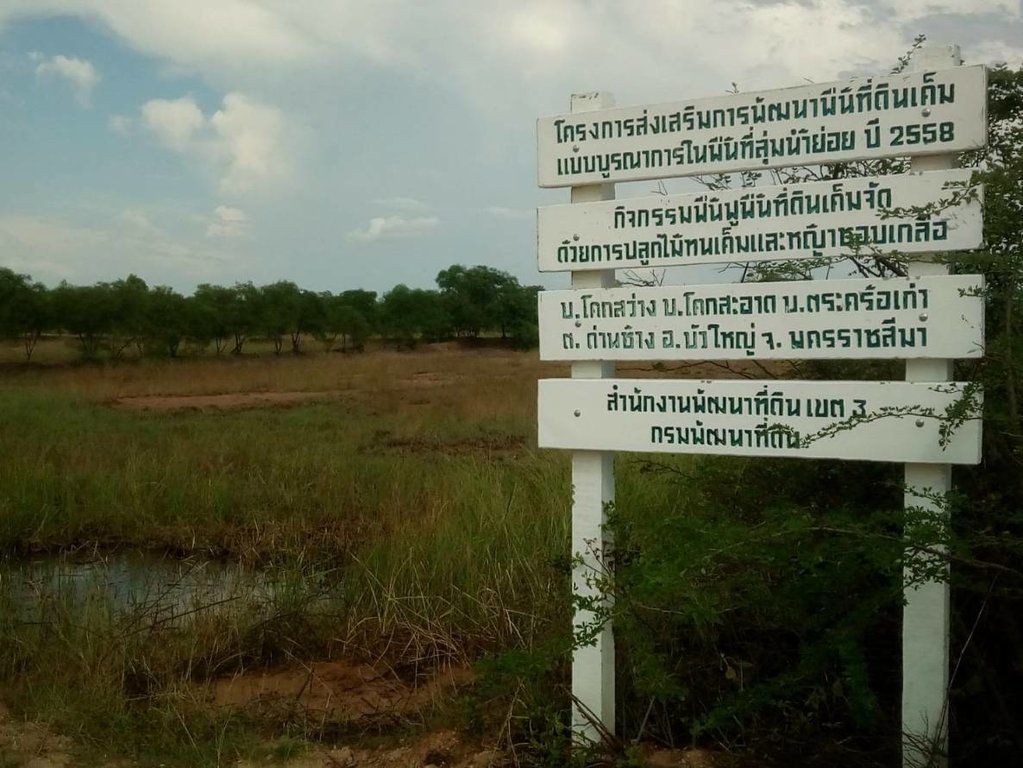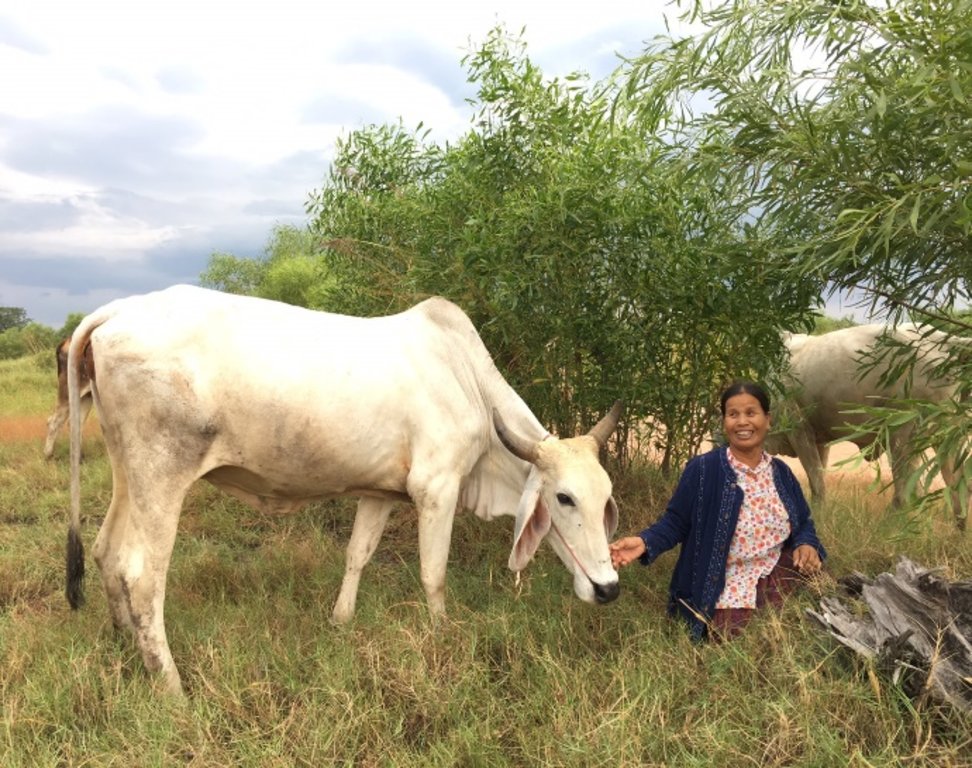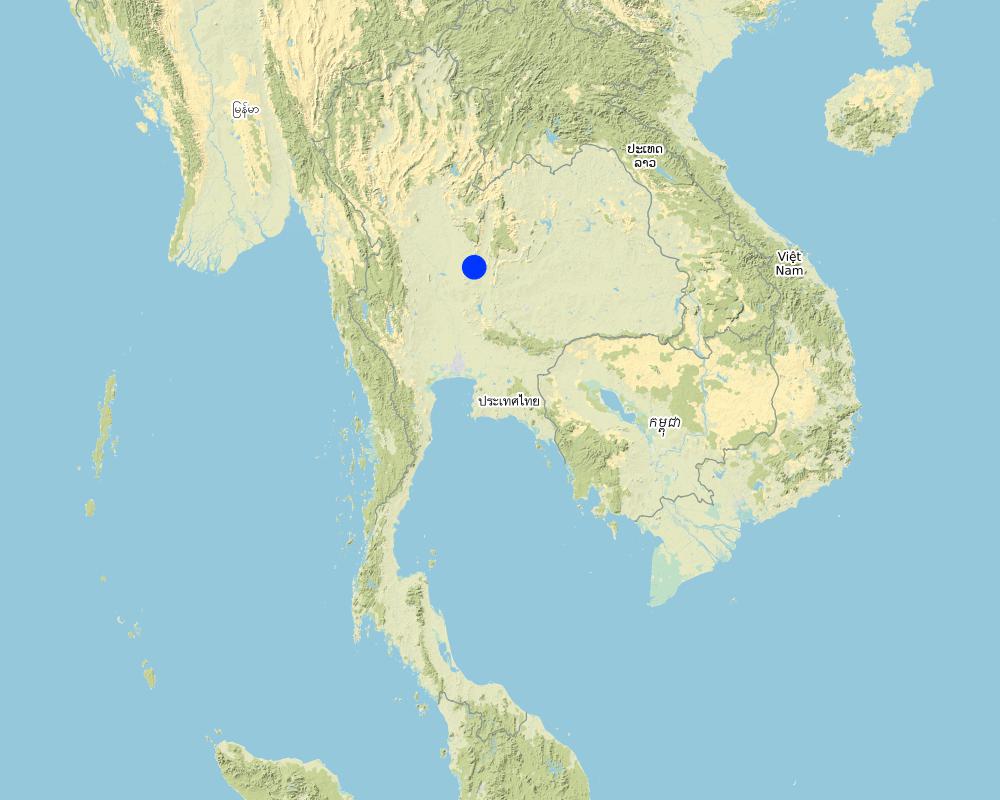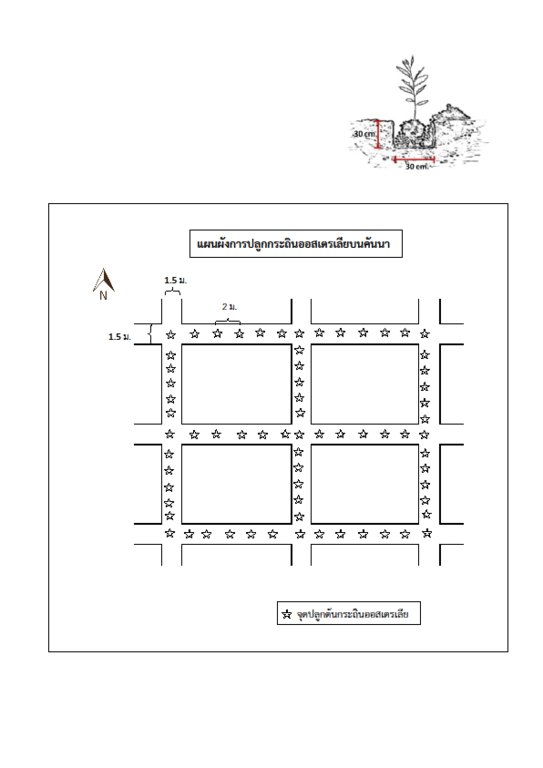Planting of Acacia ampliceps to control severely salt-affected land. [ไทย]
- ผู้สร้างสรรค์:
- การอัพเดท:
- ผู้รวบรวม: Chakkaphan Phaosrakhu
- ผู้เรียบเรียง: –
- ผู้ตรวจสอบ: Samran Sombatpanit, Rima Mekdaschi Studer, William Critchley
Planting Acacia ampliceps on severely salt-affected land leveled with ditches and dikes.
technologies_4149 - ไทย
ดูส่วนย่อย
ขยายทั้งหมด ย่อทั้งหมด1. ข้อมูลทั่วไป
1.2 รายละเอียดที่ติดต่อได้ของผู้รวบรวมและองค์กรที่เกี่ยวข้องในการประเมินและการจัดเตรียมทำเอกสารของเทคโนโลยี
วิทยากรหลัก
ผู้ใช้ที่ดิน:
Tathaisong Nurean
-
ไทย
ผู้เชี่ยวชาญ SLM:
Phaosrakhu Chakkaphan
Land Development Regional Office 3
ไทย
ผู้เชี่ยวชาญ SLM:
Chuaysanoi Phatranit
Land Development Regional Office 3
ไทย
ผู้เชี่ยวชาญ SLM:
Oechaiyaphum Kaewjai
Land Development Regional Office 3
ไทย
ผู้เชี่ยวชาญ SLM:
Prachansri Saowanee
Land Development Regional Office 3
ไทย
ผู้เชี่ยวชาญ SLM:
Phiprakon Apisit
Land Development Regional Office 3
ไทย
ผู้เชี่ยวชาญ SLM:
Prawanna Prasit
Land Development Regional Office 3
ไทย
National consultant:
ชื่อของโครงการซึ่งอำนวยความสะดวกในการทำเอกสารหรือการประเมินเทคโนโลยี (ถ้าเกี่ยวข้อง)
Decision Support for Mainstreaming and Scaling out Sustainable Land Management (GEF-FAO / DS-SLM)ชื่อขององค์กรซึ่งอำนวยความสะดวกในการทำเอกสารหรือการประเมินเทคโนโลยี (ถ้าเกี่ยวข้อง)
Land Development Department (Land Development Department) - ไทย1.3 เงื่อนไขการใช้ข้อมูลที่ได้บันทึกผ่านทาง WOCAT
ผู้รวบรวมและวิทยากรหลักยอมรับเงื่อนไขเกี่ยวกับการใช้ข้อมูลที่ถูกบันทึกผ่านทาง WOCAT:
ใช่
1.4 การเปิดเผยเรื่องความยั่งยืนของเทคโนโลยีที่ได้อธิบายไว้
เทคโนโลยีที่ได้อธิบายไว้นี้เป็นปัญหาของความเสื่อมโทรมโทรมของที่ดินหรือไม่ จึงไม่ได้รับการยอมรับว่าเป็นเทคโนโลยีเพื่อการจัดการที่ดินอย่างยั่งยืน:
ไม่ใช่
แสดงความคิดเห็น:
The technology is very well accepted by the land users.
2. การอธิบายลักษณะของเทคโนโลยี SLM
2.1 การอธิบายแบบสั้น ๆ ของเทคโนโลยี
คำจำกัดความของเทคโนโลยี:
Acacia ampliceps is a very salt-tolerant species that can grow well on the severely salt-affected area. Land leveling with ditches and dikes is needed, they were planted along the east-west direction. The technology is very well accepted by the land users.
2.2 การอธิบายแบบละเอียดของเทคโนโลยี
คำอธิบาย:
Acacia ampliceps (salt wattle, a leguminous Australian shrub, has been introduced in salt-affected areas in the Northeast of Thailand for the remediation of saline soils) is a very salt-tolerant plant that grows well on the severely salt-affected land. Leveling the land and furnishing with ditches and dikes is needed, and the trees could be planted along the affected area, appropriately along the east-west direction. The technology is very well accepted by the land users. Planting such tree on the severely salt-affected land in Kham Tale Sau, Nakhon Ratchasima Province is a subproject of the LDD project on "Planting Perennial Salt-tolerant Trees in Salt-affected Areas in the Northeast of Thailand", which started since 1997. In the subproject, Acacia ampliceps was grown on 68 rai covering >50% of salt patches of the area of heavily salt-affected barren land owned by Mrs. Nurian Tathaisong at Ban Kok Sa-ad Village, Dansay Sub-district, Buayai District, Nakhon Ratchasima Province. In a recent study, after growing the acacia tree in 2015, her land changed noticeably from barren to be covered with trees that provide shading; native grasses then returned to become grazing land and a source for fodder for her 14 cattle. The purposes of the project have been to maximize the use of the land with low input and to decrease salinity to the level that other less salt-tolerant plant species can survive and produce crop yields for some higher income, and eventually to result in better soil properties.
The technology started with locating severely salt-affected sites (approx. 45 rai), leveling the land and furnishing it with ditches and dikes. For the dimensions, the dike is 2 m wide, 0.5 m high, the top of the dike being 1.5 m wide. The ditch is 0.5 m deep and 1 m wide. Acacia ampliceps seeds are treated to break the dormancy by soaking in hot water (80°C) for 10 min before planting in the nursery. The 2-month-old seedlings are planted in a pit of 0.3x0.3x0.3 m on the dike, with an addition of 1 kg each of compost and rice husk, at a spacing of 2 m as a single row in the middle of the dike. The ridges are 20 m apart. According to the land user, 1 year after planting the native grasses that did not exist had returned while the salt crusts had disappeared. At 2-year old, the average plant height was 1.65 m and became higher than 2 m after 3 years of planting, producing 8-10 coppices per tree and lots of leaves that favor cattle shading. Acacia ampliceps wood is normally used to produce charcoal. Three years after planting the tree, the land user has converted 23 rai of less saline land to paddy fields. The acacia leaves fallen on the ground helped improve the soil properties. After a period of 3 years, the technology induced better microclimate and richer diversity of flora and fauna species, e.g. wild flowers, native grasses, frogs, dragonflies, earthworms, birds and rats. The fragrant Acacia ampliceps flowers attract bees, thus in the near future the land user prefers doing apiculture as well as producing essential oil to making charcoal. The only visible threat of Acacia ampliceps is the forest-fire risk due to its high essential oil content; the fire that may be caused by any means will damage crops in the vicinity.
2.3 รูปภาพของเทคโนโลยี
2.4 วีดีโอของเทคโนโลยี
วันที่:
28/11/2018
วันที่:
28/11/2018
2.5 ประเทศภูมิภาค หรือสถานที่ตั้งที่เทคโนโลยีได้นำไปใช้และได้รับการครอบคลุมโดยการประเมินนี้
ประเทศ:
ไทย
ภูมิภาค/รัฐ/จังหวัด:
Nakhon Ratchasima
ข้อมูลจำเพาะเพิ่มเติมของสถานที่ตั้ง :
Ban Kok Sa-ard, Moo 10 T. Danchang, A. Buayai, Nakhon Ratchasima, Thailand
ระบุการกระจายตัวของเทคโนโลยี:
- ใช้ ณ จุดที่เฉพาะเจาะจงหรือเน้นไปยังบริเวณพื้นที่ขนาดเล็ก
Is/are the technology site(s) located in a permanently protected area?
ไม่ใช่
แสดงความคิดเห็น:
On farmer's land.
Map
×2.6 วันที่การดำเนินการ
ระบุปีที่ใช้:
2015
ถ้าไม่รู้ปีที่แน่นอน ให้ระบุวันที่โดยประมาณ:
- น้อยกว่า 10 ปี (ไม่นานนี้)
2.7 คำแนะนำของเทคโนโลยี
ให้ระบุว่าเทคโนโลยีถูกแนะนำเข้ามาอย่างไร:
- ทางโครงการหรือจากภายนอก
ความคิดเห็น (ประเภทของโครงการ เป็นต้น) :
Land Development Department and Local authorities had demonstrated Acacia ampliceps plantation on farm ridges in the salt-affected area, under the project of salinity-tolerant crop plantation to suppress salt-affected soil distribution, at A. Buayai, Nakhon Ratchasima since 2014 up to now.
3. การจัดประเภทของเทคโนโลยี SLM
3.1 วัตถุประสงค์หลักของเทคโนโลยี
- ลด ป้องกัน ฟื้นฟู การเสื่อมโทรมของที่ดิน
- อนุรักษ์ระบบนิเวศน์
- รักษาสภาพหรือปรับปรุงความหลากหลายทางชีวภาพ
- Desalination
3.2 ประเภทของการใช้ที่ดินในปัจจุบันที่ได้นำเทคโนโลยีไปใช้
Land use mixed within the same land unit:
ไม่ใช่

ที่ดินที่ไม่ให้ผลผลิต
ระบุ:
Barren land
ข้อสังเกต:
There are salt crusts in the area of heavily salt-affected barren land.
แสดงความคิดเห็น:
Acacia ampliceps plantation on land leveling with ditches and ridges, had potential salinity watertable control.
3.3 Has land use changed due to the implementation of the Technology?
Has land use changed due to the implementation of the Technology?
- Yes (Please fill out the questions below with regard to the land use before implementation of the Technology)
Land use mixed within the same land unit:
ใช่
Specify mixed land use (crops/ grazing/ trees):
- วนเกษตร (Agroforestry)

พื้นที่ปลูกพืช

ที่ดินที่ไม่ให้ผลผลิต
3.4 การใช้น้ำ
การใช้น้ำของที่ดินที่มีการใช้เทคโนโลยีอยู่:
- จากน้ำฝน
แสดงความคิดเห็น:
Average annual rainfall 900-1,100 mm.
3.5 กลุ่ม SLM ที่ตรงกับเทคโนโลยีนี้
- การปรับปรุงดิน / พืชคลุมดิน
- desalination
3.6 มาตรการ SLM ที่ประกอบกันเป็นเทคโนโลยี

มาตรการจัดการพืช

มาตรการอนุรักษ์ด้วยวิธีพืช
- V1: ต้นไม้และพุ่มไม้คลุมดิน

มาตรการอนุรักษ์ด้วยโครงสร้าง
- S1: คันดิน

มาตรการอื่น ๆ
3.7 รูปแบบหลักของการเสื่อมโทรมของที่ดินที่ได้รับการแก้ไขโดยเทคโนโลยี

การเสื่อมโทรมของดินทางด้านเคมี
- Cs (Salinization/alkalinization): การสะสมเกลือหรือการทำให้เป็นด่าง

การเสื่อมโทรมของดินทางด้านกายภาพ
- Pc (Compaction): การอัดแน่น
- Pw (Waterlogging): ภาวะชุ่มน้ำ

การเสื่อมโทรมของดินทางด้านชีวภาพ
- Bc (Reduction of vegetation cover): การลดลงของจำนวนพืชที่ปกคลุมดิน
- Bq (Quantity/biomass decline): การลดลงของปริมาณหรือมวลชีวภาพ
- Bl (Loss of soil life): การสูญเสียสิ่งมีชีวิตในดิน

การเสื่อมโทรมของน้ำ
- Hg (Change in groundwater): การเปลี่ยนแปลงของน้ำบาดาลหรือระดับน้ำในแอ่งน้ำบาดาล
3.8 การป้องกัน การลดลง หรือการฟื้นฟูความเสื่อมโทรมของที่ดิน
ระบุเป้าหมายของเทคโนโลยีกับความเสื่อมโทรมของที่ดิน:
- ลดความเสื่อมโทรมของดิน
- ปรับตัวกับสภาพความเสื่อมโทรมของที่ดิน
4. ข้อมูลจำเพาะด้านเทคนิค กิจกรรมการนำไปปฏิบัติใช้ ปัจจัยนำเข้า และค่าใช้จ่าย
4.1 แบบแปลนทางเทคนิคของเทคโนโลยี
ข้อมูลจำเพาะด้านเทคนิค (แบบแปลนทางเทคนิคของเทคโนโลยี):
The technologies start with locating severely salt-affected sites and land leveling with ditches and dikes. The dike is 2 m wide, 0.5 m high, the top of the dike is 1.5 m wide. The ditch is 0.5 m deep and 1 m wide. Acacia ampliceps seeds are treated to break the dormancy by soaking in 80°C hot water for 10 min before planting in the nursery. The 2-month-old seedlings are planted in a pit of 0.3x0.3x0.3 m on the dike, with an addition of 1 kg each of compost and rice husk, at a spacing of 2 m as a single row in the middle of the dike. The ridges are 20 m apart.
ผู้เขียน:
Chakkaphan Phaosrakhu
วันที่:
09/10/2018
4.2 ข้อมูลทั่วไปเกี่ยวกับการคำนวณปัจจัยนำเข้าและค่าใช้จ่าย
ให้ระบุว่าค่าใช้จ่ายและปัจจัยนำเข้าได้รับการคำนวณอย่างไร:
- ต่อพื้นที่ที่ใช้เทคโนโลยี
ระบุขนาดและหน่วยพื้นที่:
45 rai
If using a local area unit, indicate conversion factor to one hectare (e.g. 1 ha = 2.47 acres): 1 ha =:
1 ha = 6.25 rai
อื่นๆ หรือสกุลเงินประจำชาติ (ระบุ):
THB
If relevant, indicate exchange rate from USD to local currency (e.g. 1 USD = 79.9 Brazilian Real): 1 USD =:
32.0
ระบุค่าเฉลี่ยของค่าจ้างในการจ้างแรงงานต่อวัน:
300 THB/day
4.3 กิจกรรมเพื่อการจัดตั้ง
| กิจกรรม | Timing (season) | |
|---|---|---|
| 1. | Nursery of Acacia ampliceps. | May-July |
| 2. | Preparing the pit for planting | May-July |
| 3. | Planting Acacia ampliceps | May-July |
แสดงความคิดเห็น:
There is no irrigation water, therefore planting time depends directly on the period of early rainy season which is May-July.
4.4 ค่าใช้จ่ายของปัจจัยนำเข้าที่จำเป็นสำหรับการจัดตั้ง
| ปัจจัยนำเข้า | หน่วย | ปริมาณ | ค่าใช้จ่ายต่อหน่วย | ค่าใช้จ่ายทั้งหมดต่อปัจจัยนำเข้า | %ของค่าใช้จ่ายที่ก่อให้เกิดขึ้นโดยผู้ใช้ที่ดิน | |
|---|---|---|---|---|---|---|
| แรงงาน | Cost of hired labour on planting process (cost of hired labour/ day is 300 THB, 1 rai needs 2 labourers. Hence, the total cost of hired labour is 600 THB) | rai | 1.0 | 600.0 | 600.0 | |
| วัสดุด้านพืช | Cost of Acacia ampliceps nursery (1 young seedling costs 1.50 THB). 1 rai needs 80 young seedlings. So, the total cost of young seedlings is 120 THB. | seedling | 80.0 | 1.5 | 120.0 | |
| ปุ๋ยและสารฆ่า/ยับยั้งการเจริญเติบโตของสิ่งมีชีวิต (ไบโอไซด์) | The cost of compost is 3.5 THB/kg. Rate of application is 0.5 kg/pit | kg | 40.0 | 3.5 | 140.0 | |
| ปุ๋ยและสารฆ่า/ยับยั้งการเจริญเติบโตของสิ่งมีชีวิต (ไบโอไซด์) | The cost of rice husk is 4 THB/kg. Rate of application is 1 kg/pit | kg | 80.0 | 4.0 | 320.0 | |
| ปุ๋ยและสารฆ่า/ยับยั้งการเจริญเติบโตของสิ่งมีชีวิต (ไบโอไซด์) | The cost of chemical fertilizer (15-15-15) is 20 THB/kg. Rate of application is 0.1 kg/pit | kg | 8.0 | 20.0 | 160.0 | |
| ค่าใช้จ่ายทั้งหมดของการจัดตั้งเทคโนโลยี | 1340.0 | |||||
| Total costs for establishment of the Technology in USD | 41.88 | |||||
ถ้าผู้ใช้ที่ดินรับภาระน้อยกว่า 100% ของค่าใช้จ่าย ให้ระบุว่าใครเป็นผู้รับผิดชอบส่วนที่เหลือ:
-
แสดงความคิดเห็น:
Land Development Department supports the operational budget particularly cost of Acacia ampliceps plantation, while land users are in charge of maintenance and forest fire control during dry seasons.
4.5 การบำรุงรักษาสภาพหรือกิจกรรมที่เกิดขึ้นเป็นประจำ
| กิจกรรม | ช่วงระยะเวลา/ความถี่ | |
|---|---|---|
| 1. | Forage harvesting after 1 year of Acacia ampliceps plantation | rainy season, 4 times |
แสดงความคิดเห็น:
After 1 year of planting, the native grasses that did not exist have returned while salt crusts disappear.
4.6 ค่าใช้จ่ายของปัจจัยนำเข้าและกิจกรรมที่เกิดขึ้นเป็นประจำที่ต้องการการบำรุงรักษา (ต่อปี)
| ปัจจัยนำเข้า | หน่วย | ปริมาณ | ค่าใช้จ่ายต่อหน่วย | ค่าใช้จ่ายทั้งหมดต่อปัจจัยนำเข้า | %ของค่าใช้จ่ายที่ก่อให้เกิดขึ้นโดยผู้ใช้ที่ดิน | |
|---|---|---|---|---|---|---|
| แรงงาน | Cost of hired labour on trimming process: 1. The cost of hired labour: 300 THB/8-hr day and 2. Trimming process for 1 rai requires 4 hours each time, twice a year. Hence, the total cost of hired labour on trimming process is 300 THB/rai/yr) | time | 2.0 | 150.0 | 300.0 | 100.0 |
| ค่าใช้จ่ายทั้งหมดของการบำรุงรักษาสภาพเทคโนโลยี | 300.0 | |||||
| Total costs for maintenance of the Technology in USD | 9.38 | |||||
แสดงความคิดเห็น:
Land users operate trimming process; however, labour cost is calculated.
4.7 ปัจจัยสำคัญที่สุดที่มีผลกระทบต่อค่าใช้จ่าย
ปัจจัยสำคัญที่สุดที่มีผลกระทบต่อค่าใช้จ่ายต่างๆ:
Land Development Department supports the operational budget particularly cost of Acacia ampliceps plantation at first year, then users are in charge of maintenance and forest fire control.
At the first year, the initial cost for Acacia ampliceps plantation is about 1,340 THB. This includes: the cost of hired labour on planting process, 600 THB/rai; the cost of young seedlings, approximately 120 THB/rai and the cost of compost, rice husk and chemical fertilizer, about 620 THB/rai. For the expenditure part on the 1st year, there is a hired labour for harvesting fodder in a period of 6 months, approximately 300 THB/rai (from the early to the end of rainy season). However, land user can produce fodder and have grazing land for 14 cattle for around 180 days/yr. Each cattle needs about 30 kg of fodder a day. The cost for the fodder is 1 THB/kg. Land user can save the cost for cattle feeding approx. 5,400 THB/cattle/yr. In conclusion, land user can save the cost for fodder production and grazing land approximately 1,680 THB/rai. For the expenditure part on 2nd and 3rd year, there is fodder harvesting, trimming process and charcoal production. Land users may obtain approx. 10 bags of charcoal that costs 120 THB/bag. Thus, there is a direct income from charcoal production (about 26.7 THB/rai/yr) and an increase of rice production (up to 5%). Land users can have increased income from selling rice at 100 THB/rai.
In conclusion, there is a cost of maintenance during 3 years for approx. 900 THB/rai. Part of the income, the land user can have income from the increased rice yield approx. 100 THB/rai/yr. Otherwise, charcoal production can reduce fuel’s expenditure in daily life for approx. 26.7 THB/rai/yr. Fodder production and grazing land can reduce cost of cattle feeding for approximately 1,680 THB/rai/yr. The land user, however, wants to leave the branches of Acacia ampliceps for watertable control and for cattle shading.
5. สิ่งแวดล้อมทางธรรมชาติและของมนุษย์
5.1 ภูมิอากาศ
ฝนประจำปี
- < 250 ม.ม.
- 251-500 ม.ม.
- 501-750 ม.ม.
- 751-1,000 ม.ม.
- 1,001-1,500 ม.ม.
- 1,501-2,000 ม.ม.
- 2,001-3,000 ม.ม.
- 3,001-4,000 ม.ม.
- > 4,000 ม.ม.
ระบุชื่อของสถานีตรวดวัดอากาศที่ใช้อ้างอิงคือ:
Meteorological Department
เขตภูมิอากาศเกษตร
- กึ่งแห้งแล้ง
5.2 สภาพภูมิประเทศ
ค่าเฉลี่ยความลาดชัน:
- ราบเรียบ (0-2%)
- ลาดที่ไม่ชัน (3-5%)
- ปานกลาง (6-10%)
- เป็นลูกคลื่น (11-15%)
- เป็นเนิน (16-30%)
- ชัน (31-60%)
- ชันมาก (>60%)
ธรณีสัณฐาน:
- ที่ราบสูง/ที่ราบ
- สันเขา
- ไหล่เขา
- ไหล่เนินเขา
- ตีนเนิน
- หุบเขา
ระดับความสูง:
- 0-100 เมตร
- 101-500 เมตร
- 501-1,000 เมตร
- 1,001-1,500 เมตร
- 1,501-2,000 เมตร
- 2,001-2,500 เมตร
- 2,501-3,000 เมตร
- 3,001-4,000 เมตร
- > 4,000 เมตร
ให้ระบุถ้าเทคโนโลยีได้ถูกนำไปใช้:
- ไม่เกี่ยวข้อง
5.3 ดิน
ค่าเฉลี่ยความลึกของดิน:
- ตื้นมาก (0-20 ซ.ม.)
- ตื้น (21-50 ซ.ม.)
- ลึกปานกลาง (51-80 ซ.ม.)
- ลึก (81-120 ซ.ม.)
- ลึกมาก (>120 ซ.ม.)
เนื้อดิน (ดินชั้นบน):
- ปานกลาง (ดินร่วน ทรายแป้ง)
เนื้อดินล่าง (> 20 ซ.ม.ต่ำจากผิวดิน):
- ปานกลาง (ดินร่วน ทรายแป้ง)
อินทรียวัตถุในดิน:
- ต่ำ (<1%)
5.4 ความเป็นประโยชน์และคุณภาพของน้ำ
ระดับน้ำใต้ดิน:
5-50 เมตร
น้ำไหลบ่าที่ผิวดิน:
ปานกลาง
คุณภาพน้ำ (ที่ยังไม่ได้บำบัด):
เป็นน้ำใช้เพื่อการเกษตรเท่านั้น (การชลประทาน)
5.5 ความหลากหลายทางชีวภาพ
ความหลากหลายทางชนิดพันธุ์:
- ต่ำ
ความหลากหลายของแหล่งที่อยู่:
- ต่ำ
5.6 ลักษณะของผู้ใช้ที่ดินที่นำเทคโนโลยีไปปฏิบัติใช้
อยู่กับที่หรือเร่ร่อน:
- อยู่กับที่
แนวทางการตลาดของระบบการผลิต:
- mixed (subsistence/ commercial)
รายได้ที่มาจากนอกฟาร์ม:
- 10-50% ของรายได้ทั้งหมด
ระดับของความมั่งคั่งโดยเปรียบเทียบ:
- พอมีพอกิน
เป็นรายบุคคล/ครัวเรือน:
- เป็นรายบุคคล/ครัวเรือน
ระดับของการใช้เครื่องจักรกล:
- งานที่ใช้แรงกาย
เพศ:
- หญิง
อายุของผู้ใช้ที่ดิน:
- ผู้สูงอายุ
5.7 Average area of land used by land users applying the Technology
- < 0.5 เฮกตาร์
- 0.5-1 เฮกตาร์
- 1-2 เฮกตาร์
- 2-5 เฮกตาร์
- 5-15 เฮกตาร์
- 15-50 เฮกตาร์
- 50-100 เฮกตาร์
- 100-500 เฮกตาร์
- 500-1,000 เฮกตาร์
- 1,000-10,000 เฮกตาร์
- >10,000 เฮกตาร์
พิจารณาว่าเป็นขนาดเล็ก กลาง หรือขนาดใหญ่ (ซึ่งอ้างอิงถึงบริบทระดับท้องถิ่น):
- ขนาดกลาง
5.8 กรรมสิทธิ์ในที่ดิน สิทธิในการใช้ที่ดินและสิทธิในการใช้น้ำ
กรรมสิทธิ์ในที่ดิน:
- รายบุคคล ได้รับสิทธิครอบครอง
สิทธิในการใช้ที่ดิน:
- รายบุคคล
5.9 การเข้าถึงบริการและโครงสร้างพื้นฐาน
สุขภาพ:
- จน
- ปานกลาง
- ดี
การศึกษา:
- จน
- ปานกลาง
- ดี
ความช่วยเหลือทางด้านเทคนิค:
- จน
- ปานกลาง
- ดี
การจ้างงาน (เช่น ภายนอกฟาร์ม):
- จน
- ปานกลาง
- ดี
ตลาด:
- จน
- ปานกลาง
- ดี
พลังงาน:
- จน
- ปานกลาง
- ดี
ถนนและการขนส่ง:
- จน
- ปานกลาง
- ดี
น้ำดื่มและการสุขาภิบาล:
- จน
- ปานกลาง
- ดี
บริการด้านการเงิน:
- จน
- ปานกลาง
- ดี
6. ผลกระทบและสรุปคำบอกกล่าว
6.1 ผลกระทบในพื้นที่ดำเนินการ (On-site) จากการใช้เทคโนโลยี
ผลกระทบทางด้านเศรษฐกิจและสังคม
การผลิต
การผลิตพืชผล
คุณภาพพืชผล
การผลิตพืชที่ใช้เลี้ยงปศุสัตว์
คุณภาพพืชที่ใช้เลี้ยงปศุสัตว์
การผลิตสัตว์
การผลิตไม้
คุณภาพป่า /พื้นที่ทำไม้
การผลิตของจากป่าทุกชนิดยกเว้นไม้
การเสี่ยงต่อความล้มเหลวในการผลิต
ความหลากหลายของผลิตภัณฑ์
พื้นที่สำหรับการผลิต
การจัดการที่ดิน
การผลิตพลังงาน
ความเป็นประโยชน์และคุณภาพของน้ำ
การมีน้ำดื่มไว้ให้ใช้
คุณภาพน้ำดื่ม
การมีน้ำไว้ให้ปศุสัตว์
คุณภาพน้ำสำหรับปศุสัตว์
การมีน้ำไว้ให้สำหรับการชลประทาน
คุณภาพน้ำสำหรับการชลประทาน
ความต้องการน้ำจากการชลประทาน
รายได้และค่าใช้จ่าย
ค่าใช่จ่ายของปัจจัยการผลิตทางการเกษตร
รายได้จากฟาร์ม
ความหลากหลายของแหล่งผลิตรายได้
ภาระงาน
ผลกระทบด้านสังคมวัฒนธรรมอื่น ๆ
ความมั่นคงด้านอาหาร / พึ่งตนเองได้
สถานการณ์ด้านสุขภาพ
การใช้ที่ดิน / สิทธิในการใช้น้ำ
โอกาสทางวัฒนธรรม
โอกาสทางด้านสันทนาการ
สถาบันของชุมชน
สถาบันแห่งชาติ
SLM หรือความรู้เรื่องความเสื่อมโทรมของที่ดิน
การบรรเทาความขัดแย้ง
สถานการณ์ของกลุ่มด้อยโอกาส ทางด้านสังคมและเศรษฐกิจ
ผลกระทบด้านนิเวศวิทยา
วัฐจักรน้ำหรือน้ำบ่า
ปริมาณน้ำ
คุณภาพน้ำ
การเก็บเกี่ยวหรือการกักเก็บน้ำ
น้ำไหลบ่าที่ผิวดิน
การระบายน้ำส่วนเกิน
น้ำบาดาลหรือระดับน้ำในแอ่งน้ำบาดาล
การระเหย
ดิน
ความชื้นในดิน
สิ่งปกคลุมดิน
การสูญเสียดิน
การสะสมของดิน
การเกิดแผ่นแข็งที่ผิวดิน /การเกิดชั้นดาน
การอัดแน่นของดิน
การหมุนเวียนและการเติมของธาตุอาหาร
ความเค็ม
อินทรียวัตถุในดิน/ต่ำกว่าดินชั้น C
ความเป็นกรด
ความหลากหลายทางชีวภาพของพืชและสัตว์
การปกคลุมด้วยพืช
มวลชีวภาพ/เหนือดินชั้น C
ความหลากหลายทางชีวภาพของพืช
พืชพันธุ์ต่างถิ่นที่รุกล้ำเข้ามา
ความหลากหลายทางชีวภาพของสัตว์
ชนิดพันธุ์ที่ให้ประโยชน์
ความหลากหลายของสัตว์
การจัดการศัตรูพืชและโรคพืช
ลดความเสี่ยงของภัยพิบัติ
ผลกระทบจากน้ำท่วม
ดินถล่ม/ ซากต่าง ๆ ที่ถูกพัดพามา
ผลกระทบจากภัยแล้ง
ผลกระทบของพายุไซโคลน พายุฝน
การปล่อยคาร์บอนและก๊าซเรือนกระจก
ความเสี่ยงจากไฟ
ความเร็วของลม
ภูมิอากาศจุลภาค
6.2 ผลกระทบนอกพื้นที่ดำเนินการ (Off-site) จากการใช้เทคโนโลยี
น้ำที่ใช้ประโยชน์ได้
การไหลของน้ำคงที่และสม่ำเสมอในช่วงฤดูแล้ง
น้ำท่วมพื้นที่ท้ายน้ำ
การทับถมของดินตะกอนพื้นที่ท้ายน้ำ
การเกิดมลพิษในน้ำบาดาลหรือแม่น้ำ
ความสามารถต้านทานการเปลี่ยนแปลง / ความสามารถในการคัดกรอง
ตะกอนที่ถูกพัดพามาโดยลม
ความเสียหายต่อพื้นที่เพาะปลูกของเพื่อนบ้าน
ความเสียหายต่อโครงสร้างพื้นฐานของรัฐหรือของเอกชน
ผลกระทบของก๊าซเรือนกระจก
6.3 การเผชิญและความตอบสนองของเทคโนโลยีต่อการเปลี่ยนแปลงสภาพภูมิอากาศที่ค่อยเป็นค่อยไป และสภาพรุนแรงของภูมิอากาศ / ภัยพิบัติ (ที่รับรู้ได้โดยผู้ใช้ที่ดิน)
สภาพรุนแรงของภูมิอากาศ (ภัยพิบัติ)
ภัยพิบัติจากสภาพภูมิอากาศ
| เทคโนโลยีมีวิธีการรับมืออย่างไร | |
|---|---|
| ภัยจากฝนแล้ง | ไม่ค่อยดี |
| ไฟป่า | ปานกลาง |
| ไฟบนบก | ปานกลาง |
ภัยพิบัติจากน้ำ
| เทคโนโลยีมีวิธีการรับมืออย่างไร | |
|---|---|
| น้ำท่วมฉับพลัน | ปานกลาง |
ผลลัพธ์ตามมาที่เกี่ยวข้องกับภูมิอากาศอื่น ๆ
ผลลัพธ์ตามมาที่เกี่ยวข้องกับภูมิอากาศอื่น ๆ
| เทคโนโลยีมีวิธีการรับมืออย่างไร | |
|---|---|
| ช่วงการปลูกพืชที่ขยายออกไป | ไม่ค่อยดี |
| ช่วงการปลูกพืชที่ลดลงมา | ไม่ค่อยดี |
6.4 การวิเคราะห์ค่าใช้จ่ายและผลประโยชน์ที่ได้รับ
ผลประโยชน์ที่ได้รับเปรียบเทียบกับค่าใช้จ่ายในการจัดตั้งเป็นอย่างไร (จากมุมมองของผู้ใช้ที่ดิน)
ผลตอบแทนระยะสั้น:
ด้านบวกเล็กน้อย
ผลตอบแทนระยะยาว:
ด้านบวกอย่างมาก
ผลประโยชน์ที่ได้รับเปรียบเทียบกับค่าใช้จ่ายในการบำรุงรักษาหรือต้นทุนที่เกิดขึ้นซ้ำอีก เป็นอย่างไร (จากมุมมองของผู้ใช้ที่ดิน)
ผลตอบแทนระยะสั้น:
ด้านบวก
ผลตอบแทนระยะยาว:
ด้านบวกอย่างมาก
แสดงความคิดเห็น:
Plantation cost in the 1st year is the main cost; the rest is the maintenance cost after 1-2 years of the growing period, including weed control. All kinds of weed can be used for raising animals. Hence, there is not much maintenance cost after growing the Acacia tree.
6.5 การปรับตัวของเทคโนโลยี
- 11-50%
ถ้ามีข้อมูลให้บอกปริมาณด้วย (จำนวนของครัวเรือนหรือครอบคลุมพื้นที่):
4,665 rai (746.4 ha)
Of all those who have adopted the Technology, how many did so spontaneously, i.e. without receiving any material incentives/ payments?
- 11-50%
แสดงความคิดเห็น:
Land user claimed that planting Acacia ampliceps on the severely salt-affected land can decrease salinity to about 50% after 3 years of planting. This project made farmers understand the methodology of desalination.
6.6 การปรับตัว
เทคโนโลยีได้รับการปรับเปลี่ยนเมื่อเร็วๆนี้ เพื่อให้ปรับตัวเข้ากับสภาพที่กำลังเปลี่ยนแปลงหรือไม่:
ใช่
อื่น ๆ (ระบุ):
Acacia ampliceps plantation
ให้ระบุการปรับตัวของเทคโนโลยี (การออกแบบ วัสดุหรือชนิดพันธุ์ เป็นต้น):
The farmer attempted to grow Acacia ampliceps on the leveled land with two methods. The first one: 1) To grow by removing the plastic bag and 2) To grow without removing the plastic bag. The farmers found that removing the plastic bag before planting is better, as the plant growth will not be disrupted.
6.7 จุดแข็ง / ข้อได้เปรียบ / โอกาสของเทคโนโลยี
| จุดแข็ง / ข้อได้เปรียบ / โอกาสในทัศนคติของผู้ใช้ที่ดิน |
|---|
| 1) Desalination to 40% after 3 years of planting; |
| 2) Branches of Acacia ampliceps are used as forage and for producing charcoal; |
| 3) The plants provide shade, with increased air humidity, resulting in a better atmosphere to live in; and |
| 4) The plants increase the amount of flora, especially the forage crop. |
| จุดแข็ง / ข้อได้เปรียบ / โอกาสในทัศนคติของผู้รวบรวมหรือวิทยากรหลัก |
|---|
| 1) Desalination, thus preventing the spread of salt-affected soil; |
| 2) To increase rice yield and, thus, farmers’ income; |
| 3) To induce better microclimate and biodiversity of both flora and fauna species, e.g. wild flowers, native grasses, frogs, dragonflies, earthworms, birds and rats. |
6.8 จุดอ่อน / ข้อเสียเปรียบ / ความเสี่ยงของเทคโนโลยีและวิธีการแก้ไข
| จุดอ่อน / ข้อเสียเปรียบ / ความเสี่ยงในทัศนคติของผู้ใช้ที่ดิน | มีวิธีการแก้ไขได้อย่างไร |
|---|---|
| One year after Acacia ampliceps planting, farmers had to investigate their technology, to prevent their technology from animal and fire attack. | 1) The farmer had to investigate his technology, to prevent their technology from trapping animals. They have to build firebreak. |
| 2) The farmer should request his neighbors who raise buffalos and cows to prevent their animals from destroying the technology. |
| จุดอ่อน / ข้อเสียเปรียบ / ความเสี่ยงในทัศนคติของผู้รวบรวมหรือวิทยากรหลัก | มีวิธีการแก้ไขได้อย่างไร |
|---|---|
| Farmers who do not join this project do not know how to plant Acacia ampliceps on farm dikes. Moreover, they do not know where to buy the seeds. Thus, LDD officers or farmers who are engaged with this project have to inform them. | LDD officers or farmers who are engaged with this project have to educate other farmers. |
7. การอ้างอิงและการเชื่อมต่อ
7.1 วิธีการและแหล่งข้อมูล
- ไปเยี่ยมชมภาคสนาม การสำรวจพื้นที่ภาคสนาม
Visit 1 farmer/land user.
- การสัมภาษณ์กับผู้ใช้ที่ดิน
Interview with 1 farmer.
- การสัมภาษณ์ผู้เชี่ยวชาญด้าน SLM หรือผู้ชำนาญ
The Land Development Department officers and planners (7)
- การเก็บรวบรวมมาจากรายงานและเอกสารที่มีอยู่
5
วันที่เก็บรวบรวมข้อมูล(ภาคสนาม) :
03/11/2018
แสดงความคิดเห็น:
The interviewer on field visit and interview process must be by a person who is knowledgeable about the background of this project.
7.2 การอ้างอิงถึงสิ่งตีพิมพ์
หัวข้อ, ผู้เขียน, ปี, หมายเลข ISBN:
Land Development Department
ชื่อเรื่อง ผู้เขียน ปี ISBN:
http://www.ldd.go.th/ LDD project on planting perennial salt-tolerant trees in salt-affected areas in Northeast Thailand, Mr. Pramote Yamklee,2005
หัวข้อ, ผู้เขียน, ปี, หมายเลข ISBN:
LDD project on planting perennial salt-tolerant trees in salt-affected areas in the Northeast. Thailand, Mr. Pramote Yamklee,2005
ชื่อเรื่อง ผู้เขียน ปี ISBN:
http://www.ldd.go.th/Lddwebsite/web_ord/Technical/HTML/Technical03030.html
7.3 Links to relevant online information
ชื่อเรื่องหรือคำอธิบาย:
where the land is greener - Case Studies and Analysis of Soil and Water Conservation Initiatives Worldwide
URL:
https://www.wocat.net/library/media/27/
ชื่อเรื่องหรือคำอธิบาย:
where people and their land are safer - A Compendium of Good Practices in Disaster Risk Reduction (DRR) (where people and their land are safer)
URL:
https://www.wocat.net/en/projects-and-countries/projects/drr
7.4 General comments
The questionnaire is very complicated.
ลิงก์และโมดูล
ขยายทั้งหมด ย่อทั้งหมดลิงก์
ไม่มีลิงก์
โมดูล
ไม่มีโมดูล



